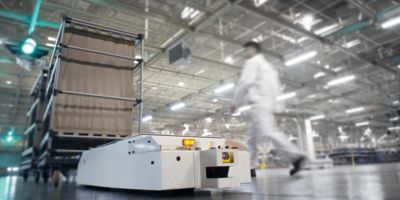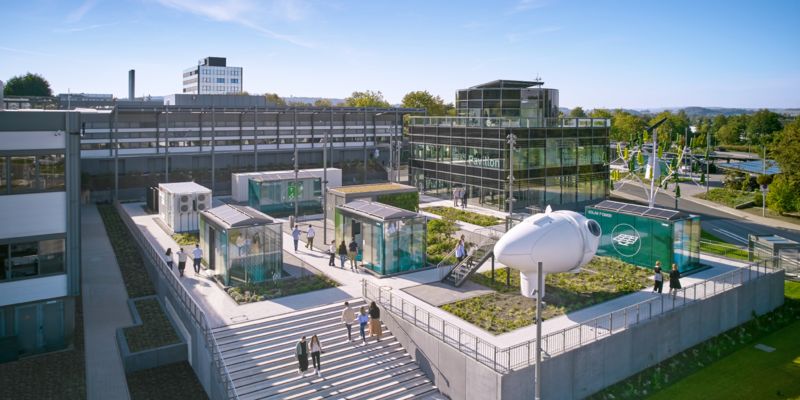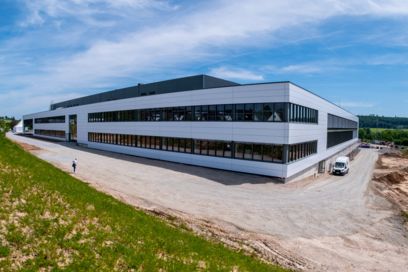Thermal coupling in the All Electric Society Park The perfect interaction between an ice storage system and heat pumps.

Brief summary
In many industries and in the private sector, heating costs and energy consumption are significant cost factors. According to the German Environment Agency, the heating sector accounts for more than 50% of Germany’s total final energy consumption. This potential offers a wide range of opportunities for business optimization and sustainable action.
Thermal coupling is a promising solution. It combines various thermal energy systems to maximize energy efficiency and resource utilization. In the All Electric Society Park in Blomberg, it plays a central role in sector coupling in order to ensure the energy self-sufficiency of the park.

One of the building blocks of the district heating and cooling network is an ice energy fence with 12 kWp
Efficient supply of heating with the district heating and cooling network
In the All Electric Society Park, a fifth generation district heating and cooling (5GDHC) network ensures maximum efficiency and sustainability of the heating supply. This central supply network covers the entire heating and cooling requirements of all the applications in the park, including the cubes, pavilion, and charging park. It is designed for low system temperatures and can be operated at a maximum temperature of up to 35°C.
One network, all the advantages
The fifth generation district heating and cooling (5GDHC) network offers
numerous advantages:
-
Low operating temperature: The 5GDHC network operates at significantly lower flow-in temperatures (5 to 35°C) compared to conventional systems (around 70°C). This reduction enables a significant increase in the efficiency of the heat pumps.
-
High efficiency: COP stands for “coefficient of performance” and indicates the ratio between the heating/cooling capacity generated or transferred and the drive power required to do so. A COP value of six indicates that the heat pump generates six units of heat energy from just one unit of electrical energy.
-
Complex energy source management: In the All Electric Society Park, seven different energy sources are used to optimize the annual performance factor (APF). These include process waste heat from production (300 kWp), two coolers (1,400 kWp), as well as waste heat from the E-Mobility Technical Center (76 kWp), waste heat from the Energy Storage (50 kWp), an ice energy fence (12 kWp), and an ice storage system (55 kWp).
-
Lower heat loss, lower installation costs: Lower operating temperatures reduce heat loss in the pipe network and thus optimize efficiency. Cost savings are also achieved by reducing the need for insulation material and insulation work.
-
Maximum year-round flexibility: The 6-line system of the 5GDHC network (2 x heating, 2 x cooling, 2 x heat recovery) enables the simultaneous provision of cooling, heating, and heat recovery. It balances simultaneous heating and cooling loads and optimizes power distribution, especially between the seasons.
It all starts with data
Comprehensive data transparency and monitoring of all energy flows are essential for efficient system operation. Over 60 thermal and 100 electrical measuring points continuously record the necessary data. Passive energy management evaluates these energy flows, while active energy management continuously monitors and optimizes them.

The Thermodynamical Center in the All Electric Society Park in Blomberg vividly demonstrates how the 6-line system of the 5GDHC network can also balance simultaneous heating and cooling loads
A heart of ice
The Thermodynamical Center, consisting of an ice storage system, two heat pumps, and an intelligent source management system, forms the heart of the system. It ensures the centralized supply of cooling and heating throughout the park. Both
Heat pumps have a heating capacity of 85.6 kW and a cooling capacity of 134 kW.
These heat pumps are operated by the park’s renewable power generation. If there is insufficient photovoltaic and wind power, stored electrical energy is used or green electricity is drawn from the public grid. The aim is to make the park almost completely energy self-sufficient.
Flexible melting
The ice storage system consists of a water-filled tank sunk in the ground. It is fitted with numerous small pipes allowing a frost-proof brine to circulate. Thermal energy is extracted from the water by an extraction heat exchanger, resulting in the formation of ice. When necessary, heat is supplied to the storage system via a regenerative heat exchanger. This heat is obtained from various sources such as an energy fence in the park or from a connected production building (process waste heat, two coolers).
The ice storage system makes use of the specific property of water to store or release significant amounts of energy when it changes phase from liquid to solid form. Around 334 J/g of energy is released or absorbed. This enables efficient storage and release of heat energy. The ice storage system is a suitable energy source for the heat pumps in the park. The ice storage system has a total capacity of 103 m³. The desired degree of icing is 80 to 90%. Depending on the season, the temperature ranges between 0 and 20°C.
Performance data
- Natural cooling capacity: 8,600 kWh
- Heating capacity of HP: 2 x 42.8 kW (5 to 7 K)
- Cooling capacity of HP: 2 x 41.6 kW (3 K)
- Cooling capacity of HP and ice storage system: 134 kW (5 K)
The big challenge in managing the energy of this “buffer storage” is to always provide sufficient cooling or heating for the consumers. This means that at the end of the heating period (winter), the ice block is ideally fully formed (80 to 90% ice coverage), and at the end of the cooling period (summer) it has melted down again (water temperature is 20°C). This is the only way in which the ice storage system can act as an efficient source for the heat pumps.
Connect with our experts

More posts

5G campus networks
Industrial application examples for wireless broadband communication.

Integral building planning
How integral building planning and digitalization are revolutionizing building construction.

The All Electric Society – how sector coupling works
Flexibility with a battery storage system and energy management.



